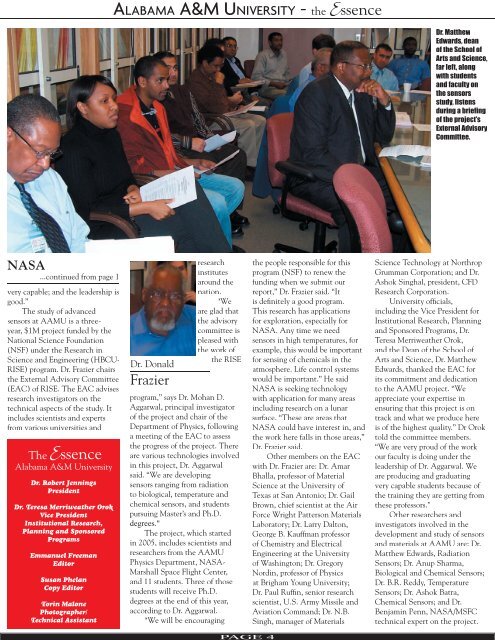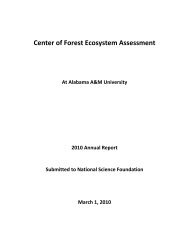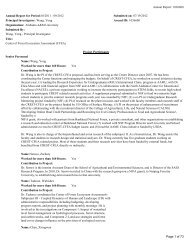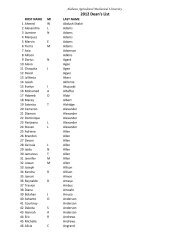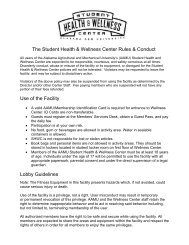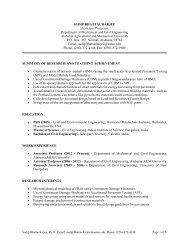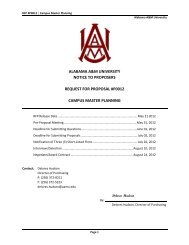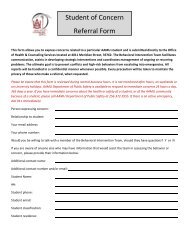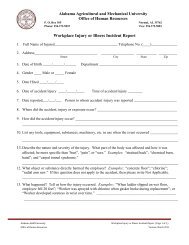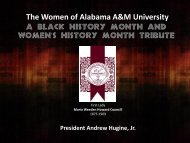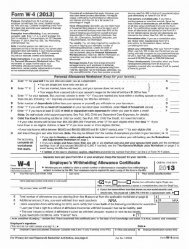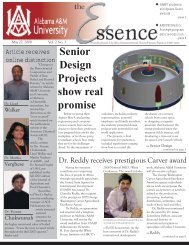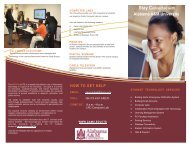The Essence Online Research Newsletter Vol.1 No.3
The Essence Online Research Newsletter Vol.1 No.3
The Essence Online Research Newsletter Vol.1 No.3
You also want an ePaper? Increase the reach of your titles
YUMPU automatically turns print PDFs into web optimized ePapers that Google loves.
ALABAMA A&M UNIVERSITY - the <strong>Essence</strong>E<br />
PAGE 4<br />
Dr. Matthew<br />
Edwards, dean<br />
of the School of<br />
Arts and Science,<br />
far left, along<br />
with students<br />
and faculty on<br />
the sensors<br />
study, listens<br />
during a briefing<br />
of the project’s<br />
External Advisory<br />
Committee.<br />
NASA<br />
...continued from page 1<br />
very capable; and the leadership is<br />
good.”<br />
<strong>The</strong> study of advanced<br />
sensors at AAMU is a threeyear,<br />
$1M project funded by the<br />
National Science Foundation<br />
(NSF) under the <strong>Research</strong> in<br />
Science and Engineering (HBCU-<br />
RISE) program. Dr. Frazier chairs<br />
the External Advisory Committee<br />
(EAC) of RISE. <strong>The</strong> EAC advises<br />
research investigators on the<br />
technical aspects of the study. It<br />
includes scientists and experts<br />
from various universities and<br />
<strong>The</strong> <strong>Essence</strong><br />
Alabama A&M University<br />
Dr. Robert Jennings<br />
President<br />
Dr. Teresa Merriweather Orok<br />
Vice President<br />
Institutional <strong>Research</strong>,<br />
Planning and Sponsored<br />
Programs<br />
Emmanuel Freeman<br />
Editor<br />
Susan Phelan<br />
Copy Editor<br />
Torin Malone<br />
Photographer/<br />
Technical Assistant<br />
Dr. Donald<br />
Frazier<br />
research<br />
institutes<br />
around the<br />
nation.<br />
“We<br />
are glad that<br />
the advisory<br />
committee is<br />
pleased with<br />
the work of<br />
the RISE<br />
program,” says Dr. Mohan D.<br />
Aggarwal, principal investigator<br />
of the project and chair of the<br />
Department of Physics, following<br />
a meeting of the EAC to assess<br />
the progress of the project. <strong>The</strong>re<br />
are various technologies involved<br />
in this project, Dr. Aggarwal<br />
said. “We are developing<br />
sensors ranging from radiation<br />
to biological, temperature and<br />
chemical sensors, and students<br />
pursuing Master’s and Ph.D.<br />
degrees."<br />
<strong>The</strong> project, which started<br />
in 2005, includes scientists and<br />
researchers from the AAMU<br />
Physics Department, NASA-<br />
Marshall Space Flight Center,<br />
and 11 students. Three of those<br />
students will receive Ph.D.<br />
degrees at the end of this year,<br />
according to Dr. Aggarwal.<br />
“We will be encouraging<br />
the people responsible for this<br />
program (NSF) to renew the<br />
funding when we submit our<br />
report,” Dr. Frazier said. “It<br />
is defi nitely a good program.<br />
This research has applications<br />
for exploration, especially for<br />
NASA. Any time we need<br />
sensors in high temperatures, for<br />
example, this would be important<br />
for sensing of chemicals in the<br />
atmosphere. Life control systems<br />
would be important.” He said<br />
NASA is seeking technology<br />
with application for many areas<br />
including research on a lunar<br />
surface. “<strong>The</strong>se are areas that<br />
NASA could have interest in, and<br />
the work here falls in those areas,”<br />
Dr. Frazier said.<br />
Other members on the EAC<br />
with Dr. Frazier are: Dr. Amar<br />
Bhalla, professor of Material<br />
Science at the University of<br />
Texas at San Antonio; Dr. Gail<br />
Brown, chief scientist at the Air<br />
Force Wright Patterson Materials<br />
Laboratory; Dr. Larry Dalton,<br />
George B. Kauffman professor<br />
of Chemistry and Electrical<br />
Engineering at the University<br />
of Washington; Dr. Gregory<br />
Nordin, professor of Physics<br />
at Brigham Young University;<br />
Dr. Paul Ruffi n, senior research<br />
scientist, U.S. Army Missile and<br />
Aviation Command; Dr. N.B.<br />
Singh, manager of Materials<br />
Science Technology at Northrop<br />
Grumman Corporation; and Dr.<br />
Ashok Singhal, president, CFD<br />
<strong>Research</strong> Corporation.<br />
University offi cials,<br />
including the Vice President for<br />
Institutional <strong>Research</strong>, Planning<br />
and Sponsored Programs, Dr.<br />
Teresa Merriweather Orok,<br />
and the Dean of the School of<br />
Arts and Science, Dr. Matthew<br />
Edwards, thanked the EAC for<br />
its commitment and dedication<br />
to the AAMU project. “We<br />
appreciate your expertise in<br />
ensuring that this project is on<br />
track and what we produce here<br />
is of the highest quality.” Dr Orok<br />
told the committee members.<br />
“We are very proud of the work<br />
our faculty is doing under the<br />
leadership of Dr. Aggarwal. We<br />
are producing and graduating<br />
very capable students because of<br />
the training they are getting from<br />
these professors.”<br />
Other researchers and<br />
investigators involved in the<br />
development and study of sensors<br />
and materials at AAMU are: Dr.<br />
Matthew Edwards, Radiation<br />
Sensors; Dr. Anup Sharma,<br />
Biological and Chemical Sensors;<br />
Dr. B.R. Reddy, Temperature<br />
Sensors; Dr. Ashok Batra,<br />
Chemical Sensors; and Dr.<br />
Benjamin Penn, NASA/MSFC<br />
technical expert on the project.


